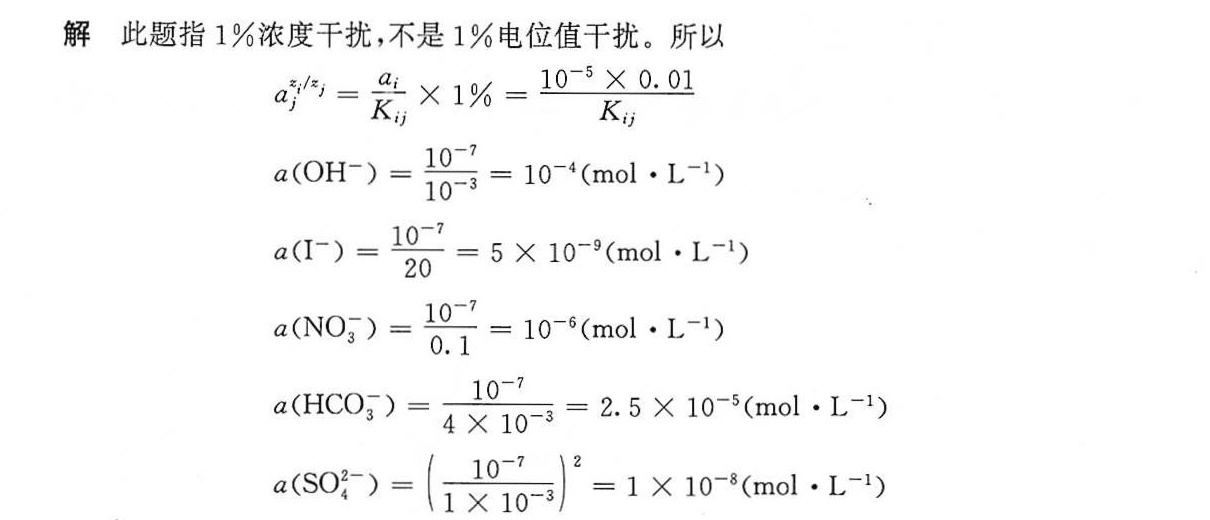题目
当用氟硼酸根液体离子交换薄膜电极测量 ^-5molcdot (L)^-1 的 (B{F)_(4)}^- 时,如果容许存-|||-在1%干扰,则容许存在的下列干扰阴离子的最大浓度是多少?括号中给出下列离子的选择性-|||-系数: -((10)^-3) ,I^-(20), (N{O)_(3)}^-(0,1), (HC{O)_(3)}^-(4times (10)^-3) (S{O)_(4)}^2-(1times (10)^-3)

题目解答
答案

解析
步骤 1:理解问题
题目要求我们计算在测量 ${10}^{-5}mol\cdot {L}^{-1}$ 的 ${B{F}_{4}}^{-}$ 时,容许存在1%干扰的情况下,容许存在的干扰阴离子的最大浓度。干扰阴离子的选择性系数已给出。
步骤 2:计算容许存在的干扰阴离子的最大浓度
根据题目,容许存在1%干扰,即干扰离子的浓度应为 ${B{F}_{4}}^{-}$ 浓度的1%。干扰离子的最大浓度计算公式为:
$$a_{j} = \frac{a_{i} \times 1\%}{k_{i}}$$
其中,$a_{i}$ 是 ${B{F}_{4}}^{-}$ 的浓度,$k_{i}$ 是干扰离子的选择性系数。
步骤 3:代入数值计算
将 ${B{F}_{4}}^{-}$ 的浓度 ${10}^{-5}mol\cdot {L}^{-1}$ 和各干扰离子的选择性系数代入公式计算容许存在的干扰阴离子的最大浓度。
$$a({OH}^{-}) = \frac{{10}^{-5} \times 0.01}{{10}^{-3}} = {10}^{-4}(mol\cdot {L}^{-1})$$
$$a({I}^{-}) = \frac{{10}^{-5} \times 0.01}{20} = 5 \times {10}^{-9}(mol\cdot {L}^{-1})$$
$$a({N{O}_{3}}^{-}) = \frac{{10}^{-5} \times 0.01}{0.1} = {10}^{-6}(mol\cdot {L}^{-1})$$
$$a({HC{O}_{3}}^{-}) = \frac{{10}^{-5} \times 0.01}{4 \times {10}^{-3}} = 2.5 \times {10}^{-5}(mol\cdot {L}^{-1})$$
$$a({S{O}_{4}}^{2-}) = \left(\frac{{10}^{-5} \times 0.01}{1 \times {10}^{-3}}\right)^{2} = 1 \times {10}^{-8}(mol\cdot {L}^{-1})$$
题目要求我们计算在测量 ${10}^{-5}mol\cdot {L}^{-1}$ 的 ${B{F}_{4}}^{-}$ 时,容许存在1%干扰的情况下,容许存在的干扰阴离子的最大浓度。干扰阴离子的选择性系数已给出。
步骤 2:计算容许存在的干扰阴离子的最大浓度
根据题目,容许存在1%干扰,即干扰离子的浓度应为 ${B{F}_{4}}^{-}$ 浓度的1%。干扰离子的最大浓度计算公式为:
$$a_{j} = \frac{a_{i} \times 1\%}{k_{i}}$$
其中,$a_{i}$ 是 ${B{F}_{4}}^{-}$ 的浓度,$k_{i}$ 是干扰离子的选择性系数。
步骤 3:代入数值计算
将 ${B{F}_{4}}^{-}$ 的浓度 ${10}^{-5}mol\cdot {L}^{-1}$ 和各干扰离子的选择性系数代入公式计算容许存在的干扰阴离子的最大浓度。
$$a({OH}^{-}) = \frac{{10}^{-5} \times 0.01}{{10}^{-3}} = {10}^{-4}(mol\cdot {L}^{-1})$$
$$a({I}^{-}) = \frac{{10}^{-5} \times 0.01}{20} = 5 \times {10}^{-9}(mol\cdot {L}^{-1})$$
$$a({N{O}_{3}}^{-}) = \frac{{10}^{-5} \times 0.01}{0.1} = {10}^{-6}(mol\cdot {L}^{-1})$$
$$a({HC{O}_{3}}^{-}) = \frac{{10}^{-5} \times 0.01}{4 \times {10}^{-3}} = 2.5 \times {10}^{-5}(mol\cdot {L}^{-1})$$
$$a({S{O}_{4}}^{2-}) = \left(\frac{{10}^{-5} \times 0.01}{1 \times {10}^{-3}}\right)^{2} = 1 \times {10}^{-8}(mol\cdot {L}^{-1})$$